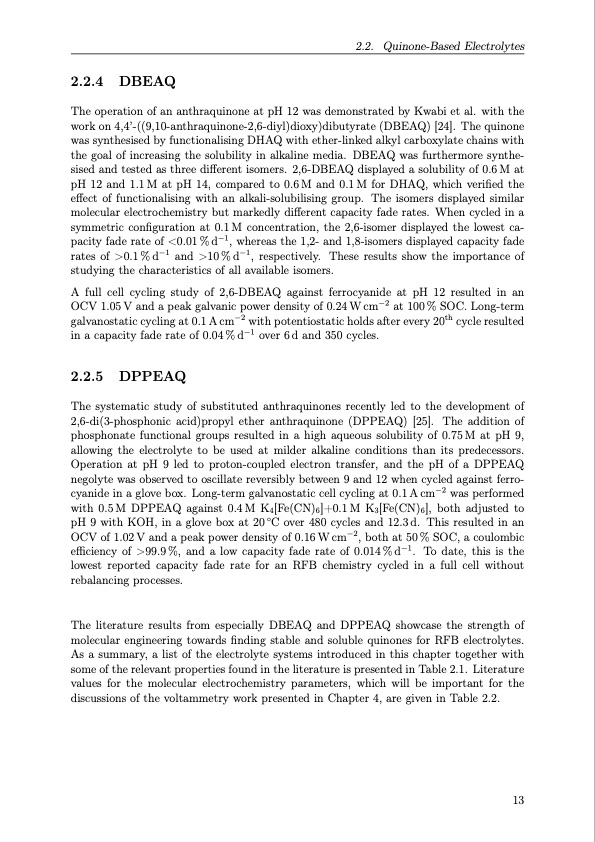
PDF Publication Title:
Text from PDF Page: 034
2.2.4 DBEAQ The operation of an anthraquinone at pH 12 was demonstrated by Kwabi et al. with the work on 4,4’-((9,10-anthraquinone-2,6-diyl)dioxy)dibutyrate (DBEAQ) [24]. The quinone was synthesised by functionalising DHAQ with ether-linked alkyl carboxylate chains with the goal of increasing the solubility in alkaline media. DBEAQ was furthermore synthe- sised and tested as three different isomers. 2,6-DBEAQ displayed a solubility of 0.6 M at pH 12 and 1.1 M at pH 14, compared to 0.6 M and 0.1 M for DHAQ, which verified the effect of functionalising with an alkali-solubilising group. The isomers displayed similar molecular electrochemistry but markedly different capacity fade rates. When cycled in a symmetric configuration at 0.1 M concentration, the 2,6-isomer displayed the lowest ca- pacity fade rate of <0.01%d−1, whereas the 1,2- and 1,8-isomers displayed capacity fade rates of >0.1%d−1 and >10%d−1, respectively. These results show the importance of studying the characteristics of all available isomers. A full cell cycling study of 2,6-DBEAQ against ferrocyanide at pH 12 resulted in an OCV 1.05 V and a peak galvanic power density of 0.24 W cm−2 at 100 % SOC. Long-term galvanostatic cycling at 0.1 A cm−2 with potentiostatic holds after every 20th cycle resulted in a capacity fade rate of 0.04 % d−1 over 6 d and 350 cycles. 2.2.5 DPPEAQ The systematic study of substituted anthraquinones recently led to the development of 2,6-di(3-phosphonic acid)propyl ether anthraquinone (DPPEAQ) [25]. The addition of phosphonate functional groups resulted in a high aqueous solubility of 0.75 M at pH 9, allowing the electrolyte to be used at milder alkaline conditions than its predecessors. Operation at pH 9 led to proton-coupled electron transfer, and the pH of a DPPEAQ negolyte was observed to oscillate reversibly between 9 and 12 when cycled against ferro- cyanide in a glove box. Long-term galvanostatic cell cycling at 0.1 A cm−2 was performed with 0.5M DPPEAQ against 0.4M K4[Fe(CN)6]+0.1M K3[Fe(CN)6], both adjusted to pH 9 with KOH, in a glove box at 20 ◦C over 480 cycles and 12.3 d. This resulted in an OCV of 1.02 V and a peak power density of 0.16 W cm−2, both at 50 % SOC, a coulombic efficiency of >99.9%, and a low capacity fade rate of 0.014%d−1. To date, this is the lowest reported capacity fade rate for an RFB chemistry cycled in a full cell without rebalancing processes. The literature results from especially DBEAQ and DPPEAQ showcase the strength of molecular engineering towards finding stable and soluble quinones for RFB electrolytes. As a summary, a list of the electrolyte systems introduced in this chapter together with some of the relevant properties found in the literature is presented in Table 2.1. Literature values for the molecular electrochemistry parameters, which will be important for the discussions of the voltammetry work presented in Chapter 4, are given in Table 2.2. 2.2. Quinone-Based Electrolytes 13PDF Image | Organic Redox Flow Batteries 2023

PDF Search Title:
Organic Redox Flow Batteries 2023Original File Name Searched:
PhD_thesis_final_dorhoff_4_.pdfDIY PDF Search: Google It | Yahoo | Bing
Salgenx Redox Flow Battery Technology: Salt water flow battery technology with low cost and great energy density that can be used for power storage and thermal storage. Let us de-risk your production using our license. Our aqueous flow battery is less cost than Tesla Megapack and available faster. Redox flow battery. No membrane needed like with Vanadium, or Bromine. Salgenx flow battery
| CONTACT TEL: 608-238-6001 Email: greg@salgenx.com | RSS | AMP |